Summary:
"Dog behavior starts with understanding the
root cause of a behavioral problem. While you can't control the genetic
predisposition and intelligence of a dog, you can control the
environment and how you go about correcting dog behavior problems. For example, you are in charge of your dog's self esteem
and confidence. Always start
by thinking through why a dog behaves like they do. Is there
something you or a family member are doing to create confusion instead
of clear expectations? Once a behavior is understood, it can
either be modified using positive reinforcement or the cause/trigger
can be
eliminated. Negative punishment involves removing something positive
such as limiting the freedom to roam around the house or a favorite
toy. The goal is
always to build your dog's self confidence while reinforcing the
positive behaviors that make him or her part of the family.
If all a dog hears is "no" (or at least more "no" than "yes"), then it is no wonder that a dog lacks confidence and direction). Each type of behavior problem is detailed below such as digging, chewing, barking, licking and aggression. We suggest starting with the first video and then skipping down to the list of articles that provide detailed information on each type of desired canine behavior. Last, you can consult with a veterinary behaviorist or ask our Vet a question which we will answer for free on a first come, first served basis."
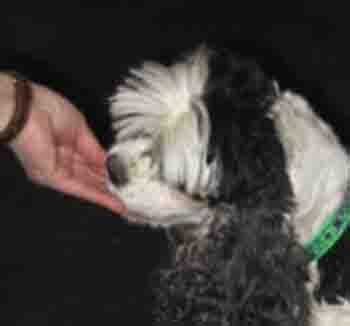
Overview
If you’re going to have a dog, it helps to understand some of the basics of canine behavior. You’ll want to know what is normal behavior and how to deal with problem behavior. You'll also want to know some of the basics when it comes to care.
Sometimes a dog's actions speak louder than words.
Dogs exhibit a wide range of behaviors to communicate their feelings, desires, and intentions. Understanding these behaviors can help you better interact with and care for your canine companion. Here are some common dog behaviors and what they mean:
- Tail wagging: Usually indicates happiness, excitement, or contentment. However, a stiff wagging tail could also signal alertness or aggression.
- Barking: Can signify various emotions, such as excitement, fear, or territorial behavior. The tone, volume, and frequency of the bark can provide clues to its meaning.
- Whining: Often indicates distress, anxiety, or a desire for attention. Dogs may whine when they're in pain, feeling lonely, or wanting something.
- Growling: Typically a warning sign that a dog is uncomfortable, fearful, or aggressive. Growling can precede a bite, so it's essential to address and resolve the underlying issue.
- Licking: Can signal affection, submission, or an attempt to groom themselves or others. Dogs may also lick to soothe or clean a wound.
- Panting: A natural way for dogs to cool down when they're hot or exerting themselves. Heavy panting could indicate stress, pain, or medical issues.
- Rolling over: Exposing their belly may show submission or trust. In a playful context, it can be an invitation to engage in play.
- Play bow: A dog will lower its front legs and raise its rear end, signaling an invitation to play.
- Head tilt: Usually indicates curiosity or confusion. Dogs may tilt their heads to better understand a sound or perceive a situation.
- Pacing: Can be a sign of anxiety, restlessness, or boredom. It may also indicate an underlying medical issue or discomfort.
- Begging: A learned behavior where dogs seek food or attention from their owners.
- Chewing: Normal for puppies during teething but can also be a sign of boredom or anxiety in adult dogs. Providing appropriate chew toys can help alleviate this behavior.
- Marking: When a dog urinates on objects to claim territory or communicate with other dogs. More common in males but can occur in females as well.
- Digging: A natural behavior often driven by instincts to bury food, build a den, or hunt for prey. Providing a designated digging area or engaging in enrichment activities can help curb excessive digging.
- Yawning: While dogs yawn when they're tired, it can also be a sign of stress or anxiety. In some cases, it serves as a calming signal to other dogs.
Canine Behavior Problems - List of Site Articles
- Introducing A New Cat to a Dog
- Barking - How to stop dog barking
- Chewing
- Destructive Behavior
- Digging
- Licking
- Dog Pack Behavior
- Puppy Behavior
- Reactive Tools and Behaviors
- Sleep Restlessness
Sometimes behavior problems are related to boredom or a way for a dog to get our attention. If you believe this is the case look at our guide to How to Make Your Dog Happy. Additional tips can be found on our article on puppy obedience training.
Aggressive Behavior
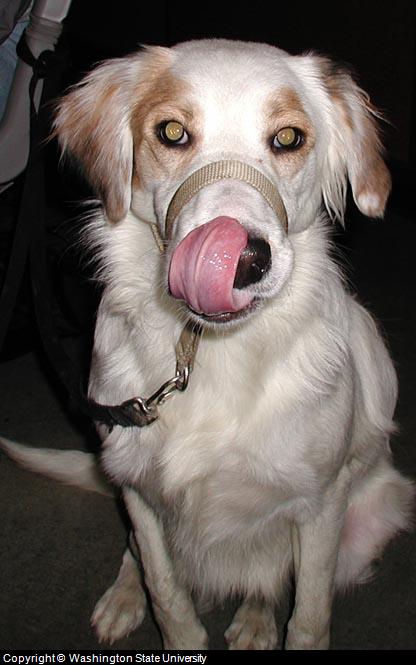
For example, teaching your dog without a lead to "come" lets him or her choose whether or not to obey. If you are holding a lead and can reinforce the request by pulling the dog to you, the dog learns who is the "alpha dog".
Source: WSU Veterinary School
Recognizing Different Types of Canine Behavior
This help video from "Dog Whisperer" Cesar Millan shows real life dog behavior examples.
Dog Aggression Tips
Aggressive
behavior in dogs is not a normal or acceptable. If a dog is
growling, snarling, snapping, and/or biting at
you or family members, then it is showing behaviors that need to be
modified. The first signs of aggression much be corrected in order to
keep it from becoming a long term problem.
Dog behavior issues such as aggression can also evolve over time and can show itself unexpectedly. For example, a dog might also place more importance on a possession such as a toy or roll of toilet paper. Anyone that disturbs or comes near that object might be the target of aggressive behavior.
Causes:
The leading cause of aggressive dog behavior is dominance. Dogs are pack animals. Aggression means that a dog objects to you being the leader of the pack. Signs are a dog get possessive in that once they obtain a toy, an area of the home or food will try and keep it. Some dogs will get aggressive when they are prevented from an activity that they like to do. Dominance dog aggression is often to other family members. The dog is acting in contempt due to the weak social standing of the family member, sometimes exhibited by a person that always gives in to requests for more food or petting. A dog can even be aggressive to only the most dominant person in the family, since this is the only person worthy of the challenge.
Dogs might also exhibit different levels of aggressive dog behavior during different times of the day. In the morning a dog might be safe while in the evening it might not.
Puppy Aggression:
Often aggression starts as a puppy while testing different behaviors. If they growl and get to keep an object such as a ball, then they learn that not only is the aggressive behavior acceptable, but that it is rewarded, in this case by keeping the ball. If you think about how a puppy learns, at first if it bites too hard on the mom underbelly during feeding, the mother dog will rebuke the pup. If the puppy then bites a littermate, they are also rebuked. When the puppy comes home with a person, if they are not clearly warned against biting (a firm "stop it" or tap on the nose with a finger) then they think the person is a new toy and they will continue the behavior. Another approach is to put your hands in your pocket after being nipped. With a puppy it is only natural for them to explore with their mouths, but once it gets harder, then you need to withdraw the pleasure, your warm reaction, from the behavior.
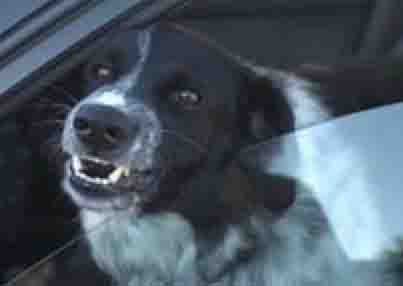
Photo Credit: Best Friends Animal Society
Signs of Dog Aggression:
Dogs exhibiting aggressive behavior will exhibit one or more signs. Owners cannot always see the signs as they can be subtle and are expressed through posture, maneuvering and expression (4). The easiest way to recognize an aggressive posture is to note any changes from normal along with one or more of the signs listed below.
- Fear Based Aggression
- Lay back the ears
- Tail between legs (a dog that appears to be passive may still attack, always be cautious)
- Avoidance of eye contact
- Lowered head and tail
- Tense body posture
- Horizontal lip retraction
- Lip licking
- Yawning
- Crouched body
- Moving slowly or freezing
- Submission urination
- Dominantly aggressive, territorial or possessive dogs
- Stand stiff and erect (looks taller than usual)
- Eyes focused in a stare
- Ears upright and forward
- Tail upright
- Vertical lip retraction
- Forward lean
- Other Signs of Aggressive Behavior
- Bare teeth
- Biting
- Growling
Dog Aggression Training: Correcting Aggressive Dog Behavior
Puppies should also be trained out of aggression as a fear response, particularly to people. Puppies that are not around people can learn to fear them. Later in life when visitors come to the house they may act out this fear with aggressive behaviors.
Take your dog to the veterinarian to rule out physical causes for his or her aggression. Then seek help from a dog behavior specialist. Don’t allow aggressive behavior to continue - it won’t get better on its own, and will probably just get worse. Until you are able to get help to correct the issue, keep your dog confined as necessary to keep people safe.
Fear Aggression Training:
Then read the signs for aggression. If a dog is aggressive due to fear, then your dog requires more exposure and socialization. A fearful dog sometimes proactively acts dominant out of fear that if they don't go on the offensive, they will be harmed. Often fear aggression response is learned early in life as the result of some type or traumatic occasion. Treatment involves understanding and avoiding the fear trigger.
Dominance Aggression Training
If the aggression is due to possessiveness, territorial aggression or the need to be dominant, then an obedience program with a trainer or dog behaviorist is needed to send a clear signal that the humans in the household are dominant. The key to rehabilitation is to re-establish dominance over the dog. Training involves making the dog work to get things it takes for granted. The dog needs to feel dependent on the people in the family for attention, praise, food, exercise and toys. This approach works within 2 months in 90% of cases.
Regardless of the cause, reducing arousal and redirection can be helpful. Undergoing behavior modification with desensitization and counter conditioning (DSCC) can help, including approaches where triggers are reintroduced.
Using a cue-response-reward interaction between you and your dog can help to reduce aggressive behaviors. Medications may also help to lower the size of reactions to triggers and the overall level of arousal.
For Additional Reading and Dog Aggression Training Tips:
- Aggressive
Behavior Overview
- Dominance Behavior
- Fear Aggression
- Territorial Aggression
- Predatory Aggression
- Dog Aggressive Behavior Toward Owner
- Aggressive Behavior Toward New Baby
- Alpha
Dog Behavior
Behavior Problems in Adopted Dogs
Dogs that are adopted may present certain behavioral problems as the result of past abuse or emergency living conditions such as when a dog owner gets sick or moves to a shelter. According to the Clinicians Brief approximately 67% of dogs that are adopted are taken to a clinic due to one of the following problem.
The most common behavioral problems exhibited by adopted dogs include:
- Coprophagia (eating feces)
- Pica (eating of non-food substances such as garbage, metal, plastic and cloth)
- Escaping from home
- Behavior that is hard to control (hyperactivity, mouthing, jumping)
- Fear response
- Destructive behavior such as house soiling
- Aggressive behavior
Pet parents should ask their veterinarian about avoiding potential behavior issues at the first wellness visit.
Common interventions include:
Dog House Soiling Intervention
Because dog's are in a restricted space in a kennel, many dogs will eliminate urine or feces in the kennel. To change this behavior pet parents should review the basics related to in-home training. Tips include keeping your dog on a schedule for walks, supervision, and opportunities for elimination every hour after a meal or naps. Avoid punishment for this behavior and use positive reinforcement such as treats.
Coprophagia (eating feces)
Dogs are pre-programmed to clean the area where they live. If a dog lived in a shelter, the eating of feces would be consistent with this behavior. In the new home, keep your dog's living area clean to eliminate this behavior.
Separation Anxiety in Adopted Dogs
Signs of separation anxiety in adopted pets include:
- Improper elimination of urine or feces
- Excessive barking
- Destructive behaviors
- Panting, pacing, whining
- Breaking through barriers and attempts to escape
Sometimes separation anxiety is confused with fear of confinement (confinement anxiety) Options including having a substitute person stay with the dog, placing your dog in doggy daycare if no one is home for an extended period or medications.
Creating a safe space for your dog can also help. Consider touches such as playing calming classical music, puzzle toys to occupy your dogs curiosity and intellect, warm soft bedding and a food-dispensing device. Scented "find-it" type activities can also be helpful.
Medications of choice include products that enhance the production of serotonin such as the following. Note that medication can take 6 to 8 weeks of use before they are effective.
- Fluoxetine - 1-2 mg/kg every 24 hours
- Clomipramine - 1-3mg/kg every 12 hours
- Trazodone - 3-8 mg/kg every 8 to 12 hours
- Clonidine - .007-.049 mg/kg every 12 hours
- Alprazolam - .02-.1 mg/kg every 4 hours
- Iorazepam - .02-.05 mg/kg every 8 to 12 hours
You can also consider the use of pheromones.
Fear Behaviors
Each dog will react to fear differently. Fear is usually related to poor socialization when 2 - 7 weeks of age.
Signs of fear include:
- Biting
- Snapping
- Lunging
- Freezing
If you have a dog that is aggressive you need to understand potential triggers. Approaches for correction include behavior modification via counter conditioning (DSCC).
Dogs not exhibiting aggressive behavior should be given a safe space and time for adjustment into their new home. medications may also help:
- Fluoxetine - 1-2 mg/kg every 24 hours
- Comipramine - 1-3 mg/kg every 12 hours
- Buspirone - .5-2 mg/kg every 12 hours
Using medications during the transition period only can also help ease a dog into a new environtment.
Aggression
Using a cue-response-reward interaction between you and your dog can help to reduce aggressive behaviors. Medications may also help to lower the size of reactions to triggers and the overall level of arousal.
See above for a complete discussion of aggression in dogs.
Leash Reactivity
Signs of leash reactivity in dogs includes:
- biting
- snapping
- lunging
- pulling
- barking
Motivations for this type of behavior can be to product food or fear.
Treatment for this problem usually includes a change in leash such as the use of a head collar, non-retractable 4 to 6 foot leash or a front clip harness. Pet parents should consider:
- Situation avoidance - turning away from a potential trigger
- Hiding behind objects to shield a dog from a trigger
- Adding space between the dog and trigger
Dogs should be rewarded when walking for maintaining a focus on the pet parent. Learn about walking skills to help with the training. Consider behavior modification techniques of a dog is not progressing. You can also consider the pros and cons of using a muzzle if biting when outdoors is an issue.
Food Aggression
Aggression around food is a normal behavior in dogs. Management involves making interactions with the pet family predictable. Make eating into a routine and NEVER remove the food during a meal. Do not force the presence of humans when the dog is eating. You can start by having your dog eat away from the family, but then have a second bowl with treats closer to the family. Distances can be closed over time.
Resource Guarding
If a dog is guarding resources such as an object, person or toy, this can be treated via behavior management. Consider teaching the dog to trade-up to a more attractive object. Trading up involves letting the dog hold on to the new object or item (e.g.; food reward). You can also provide a reward when a dog drops the item in question.
Call the dog over to the new object and provide a reward. Teach alternative behaviors such as touching the dog to help redirect them from the trigger.
A Lesson in Aggression - Dog Whisperer
Barking
Dogs bark. They bark to warn us of strangers, to let us know when they need to go outside, to tell us when they are hungry, when they get excited, and for many other reasons. Sometimes dogs bark too often, which is known as nuisance barking.
There is a healthy level of barking. Some dogs express happiness with a happy bark when something demanding or exciting happens. These dogs will stop barking with a command such as ("No-bark", "Quiet") as a signal that fun time is over. Other dogs such as Cavoodles do not bark as much since they are genetically predisposed to be a calmer breed.
Dogs who have not been properly socialized will bark excessively when guests are over. The socialization process starts from birth, by making sure that your puppy gets used to spending time with different people and in different circumstances. With exposure to noises and people, comes familiarity, which reduces the need to bark as a dog gets older.
Dogs also tend to bark when they have been left alone for long periods of time, often as a result of boredom. Make sure your dog has plenty of toys to occupy him, and give him plenty of exercise. Tired dogs are less likely to bark. You can also try a stop barking dog collar which uses a small punishment such as a sound or smell to discourage barking.
To stop neighbors barking dog you can use an outdoor anti barking device which uses an ultrasonic tone that only dogs can hear. It is activated by barking and works from 50 feet away. The tone is irritating to a dog, so a dog will learn to avoid those actions that cause the tone to go off. You can also review our tips on excessive dog barking or this article on the pros and cons of bark collars.
As an alternative you can select a non barking dog breed (all dogs make some type of noise) or select a dog that has a calm temperament. As a last resort there is a surgical procedure called debarking that will reduce barking but is obviously controversial.
Dog Barking Training Tips: (3)
- Start with a basic method of dog behavior training such as a
leash and collar. Give the leash a small jerk when the dog is barking.
If your dog is not on a leash, then use a shaker can for dog training to indicate that
you are not happy with the behavior.
- If dog barking occurs when the dog is alone, try leaving the radio on in the room. Another approach is to tape the family talking and then let that play. During taping, tape the word "no" about every ten minutes.
- Pretend that you are leaving the house such as grabbing the keys. Exit the house, but then quickly re-enter when your dog starts to bark. You might need to get in the car or push an elevator button for a convincing performance. Once you quickly re-enter the home, show your disapproval. This can be the use of a shaker can, or place a drop of lemon juice on your dog's tongue. Repeat the lemon juice dog training process 5 or 6 times. Be sure to show your disapproval.
For Additional Reading:
There are many helpful dog behavior tips in this stop dog barking video:
Video: Dog Barking
Dog Chewing Problems
Dogs have a need to chew things, especially puppies when teething. It is perfectly natural. However, as dog owners, we don’t want them to chew our shoes and other items. The number one cause of the problem is boredom. To prevent chewing from becoming a destructive behavior, it is important to provide your dog with plenty of appropriate chew toys. You also need to realize that many dogs chew when they are bored. Make sure to give your dog plenty of playtime.
You can also try a product made to deter the chewing of specific objects such as bitter apple spray. Your dog will get the idea that chewing on acceptable objects is a much better idea.
If you must be gone for long hours during the day, consider having a pet sitter come in to walk your dog in the middle of the day or consider taking your dog to a “doggie daycare.” You can even try using a dog sitting or walking service to keep your dog occupied and happy.
Separation anxiety is another cause for destructive or chewing dog behavior. To correct separation anxiety in dogs, the dog needs reassurance that you will return. This is done by leaving for the home for a few minutes and then returning, slowing expanding the length of time you are away. Do this several times in one day. You can also reduce separation anxiety when you travel by following some of these travel tips such as keeping your dog in his home environment with a house sitter or sending your dog to a pet hotel with some familiar objects.
For Additional Reading:
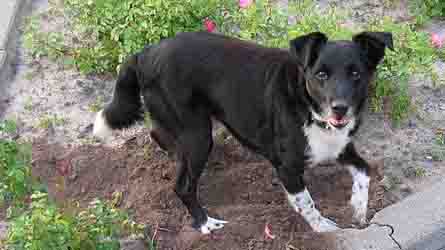
Photo Credit: Tup Wanders
Digging Behavior
Digging is another natural dog behavior exhibited by perfectly healthy dogs that can drive owners crazy. In nature digging provides a place where a dog can create a den or provide shelter for puppies. There are several reasons why your dog might be digging. The key to correcting the behavior is to try and identify the reason, and then take one of the corrective actions recommended below.
- Trying to Get At a Hidden Animal in the Ground: Hunting is a natural dog behavior, particularly among certain breeds. If you can, remove small animals from your property. Live traps are a humane way to capture and then move a small rodent or squirrel to another area.
- Burying to Hide a Favorite item: Try and eliminate from your yard the types of things that your dog buries. Dog bones are often the cause. You can also train your dog to bury items in a more acceptable area set up just for them.
- For the fun of it as a form of play: The choices are to either create an area for your dog to dig or block the area with a fence. Another option is to place a training device in the area you would like your dog to avoid such as a Snappy Trainer. These will will harm the dog and will make a loud noise whenever the dog ventures into an area that is off limits.
- To create a place where they can keep cool or warm: To correct this dog behavior consider adding an alternative to your yard such as a well ventilated dog house. An outdoor bed may also provide a place for your dog to lay down outdoors.
- To get at food in the ground such as plant roots: Try and remove or fence what is of interest to your dog. The Snappy Trainer mentioned above could also be of help.
- To escape confinement such as in a yard: First determine if your dog escapes due to separation anxiety of because of fear. Signs of separation anxiety are trembling, pacing, whining, howling or destroying items to get your attention. If fear is the problem the key is to try and determine what is the dog afraid of and then using behavior modification techniques (strangers, lightening etc.). Anti-anxiety natural (e.g; Pet Calm) or prescription medicines may be of help if recommended by a veterinarian. If your dog simply likes to escape for the fun of it, then the best approach is better fencing, or the use of electronic and actual fencing.
- As the results of some other behavior problem such as separation-anxiety.
Dogs will often dig in the yard when they have been left outdoors for too long with nothing to do. Make sure your dog has appropriate toys to play with, and play with him as well. Dogs will also dig so that they can lie in the cool dirt when it’s hot outside. Make sure your dog has a cool place to rest outdoors.
Many dogs pretend to dig. This could be an innate behavior where dogs like to "fluff up" bedding, or an expression of being anxious or excited. To stop this behavior try making a noise to startle the dog when they do it. They call the dog over to you and ask him to sit as you praise. The goal is to replace the energy that goes into digging into an alternative form of energy such as coming over to you for praise, to play or for a walk.
For additional reading on correcting dog behavior:
Excessive Dog Licking
Licking is a natural dog behavior learned at birth with the mother licking the puppy. It is how some dogs to express themselves. The key to correcting this behavior is to understand why it is occurring in a way that is uncomfortable for the pet parent. Also, dogs sometimes misinterpret our desire, and will lick more to try and please the owner. It is also a good idea to rule out any medically based reasons for excess licking such as pain (injury), skin allergy or fleas. Psychological disorders such as OCD (Obsessive Compulsive Disorder) can also be a root cause.
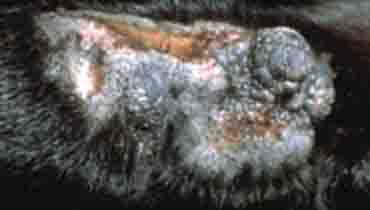
A veterinarian can diagnosis a dog yeast infection during a clinical examination. The vet will check the ears using a device called an otoscope. They can also inspect any fluid under a microscope. Tests are designed to determine if there is an excessive amount of yeast on diseased skin or ears using a fungal culture reviewed under a microscope.
Tips for correcting dog licking:
- Be Consistent: Don't allow licking some of the time, and not other times. The lack of consistency is confusing for the dog and sends a mixed signal.
- Make Your Skin Less Appealing: Apply a training spray to your skin such as Bitter Apple. The bad taste will deter future licks.
- Act As If In Pain: Dogs will not want to hurt you.
- Provide An Alternative: Some dogs just need to show they like you. Consider another trick such as shaking hands or stomach rub as a way to provide your dog with an outlet for affection.
- Behavior Modification: Work with a trainer to teach your dog an alternative dog behavior such as chewing on a toy or play. The combination of a command and alternative behavior can be helpful.
Dog Licking Paws
Note that a dog may also lick the paws due to a foreign object in the paw or a condition called acral lick dermatitis. It can be caused by a behavioral problem or an underlying medical condition such as arthritis.
Large breed dogs such as Doberman pinschers, Great Danes, German shepherds, Labrador retrievers, Golden retrievers and Irish setters are most commonly affected by acral lick dermatitis.(6). Treatment involves dog behavior modification and the treatment of any symptoms including any damage to the paw. Some believe that the self injury is the result of boredom. In this case an increased exercise schedule, play with other dogs and increased play with toys is called for.

For additional reading (PDF Downloads):
Ask Our Vet A Question, We'll Answer It For Free
Have A Dog Behavior Question or Story?
Do you have a question for our veterinarian about Dog behavior? If yes, we will answer it for free.
We will do our best to get back to you quickly (depends on how many questions we receive each day). If you do require an immediate response we suggest using this online dog veterinary service that is available now.
What Other Visitors Have Said
Click below to see contributions from other visitors to this page...
Dog Licking Furniture 




My Havanese Bichon, male, 3 yrs old has been licking my bedspread, and chairs very heavily. I'm sure he has allergies as everybody in NJ does. Last year …
Dog Wees When Excited 




My 9 month female, unspayed Cavoodle wee's when anyone comes into the house. This could be someone familiar in the family or a friend who she may have …
Dog Unable to Jump on Furniture 




Dog Unable to Jump on Furniture Reader Question
My 10 year old Chihuahua/Dachshund neutered female mix is unable to jump on the furniture. What would …
Stop Dog From Begging for Food Not rated yet
My dog constantly begs everyone for food and I know I started this bad behavior and I need to figure out how to get my dog to stop begging me for my food. …
Stop Dog from Begging for Food Not rated yet
My dog constantly begs everyone for food. I know I started this bad behavior and I need to figure out how to get my dog to stop begging me for my food. …
Dog Eats Other Dog’s Stools Not rated yet
My flat-coated retriever has always tended to eat dog feces when out on a walk. We have never been able to stop this behavior even using treats as rewards. …
Male Dog Aggressive Behavior vs. Another Male Dog Not rated yet
I am dog sitting for a friend. My male yorkie will not leave the male dog alone. My yorkie follows him around, sniffs/licks him, whines (loudly)and shakes. …
Dogs Barking at Night Not rated yet
I have 2 dog's. . .a Shep/Rottie mix, and a Lab mix. Both are pretty good. The bark now and again, normally at people that are too close to the house. …
How to Train Aggressive Dog Not rated yet
My dog is overprotective of her mom. My dog barks and rushes when anyone enters the house - even people who she is familiar with. She growls at my husband …
Puppy Biting and Chewing Problem Not rated yet
I have a puppy biting and chewing problem with my 8 month old Jack Russel, white and deaf. We love her to death, she chews,,,,and chews. Is it possible …
Separation Anxiety - New Home Not rated yet
Dog Separation Anxiety in New Home Reader Question
Our daughter has left the country for two years and we have her basset/Australian cattle dog. Hiedi …
References:
(3) How to Get Your Dog to Do What You Want Eckstein, Warren
(4) Dogs Behaving Badly An A to Z Guide to Understanding & Curing Behavioral Problems in Dogs Dodman, Dr. Nicholas

